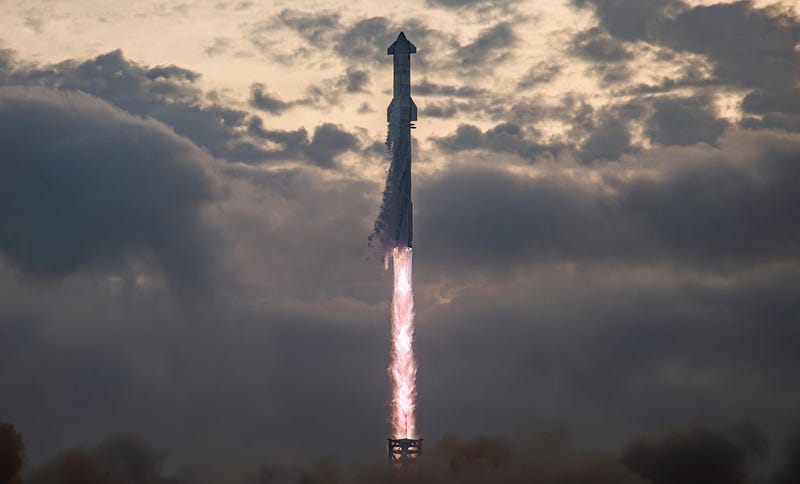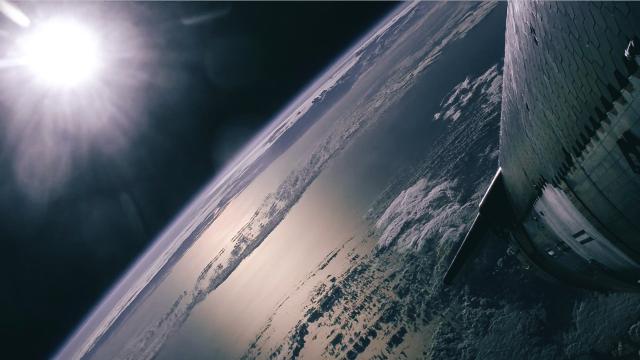The third test flight of Starship on March 14 marked a huge victory for SpaceX, with the experimental rocket hitting a number of key milestones. The unplanned loss of both stages triggered a Federal Aviation Administration investigation, but neither the FAA nor SpaceX anticipate the lengthy delays experienced after the first two tests.
Starship’s second test flight, conducted on November 18, 2023, happened 30 weeks (212 days) after its inaugural demo last April. That launch was a total fiasco, resulting in a protracted federal investigation. The length of time between the second and third tests fell to nearly 17 weeks (117 days), which was better but still not great, as far as SpaceX is concerned.
Recent comments from Gwynne Shotwell, SpaceX’s president and chief operating officer, suggest the fourth flight could happen in about six weeks, which would take us to early May. That would obviously be the quickest turnaround yet. Given how things went down during the third test on March 14, it’s not a completely outrageous projection.

SpaceX achieved many key objectives during the 49-minute third test flight, despite late failures from the Super Heavy booster and the upper stage vehicle. Key milestones for the mission included the launch of the fully integrated Starship, the lighting of all 33 booster engines, a hot staging maneuver and stage separation, placing Starship in a suborbital trajectory, opening and closing its payload door, and an in-flight demonstration of propellant transfer.
The mission did fall short in a few areas. An upper stage Raptor engine couldn’t be reignited in space due to the vehicle’s unanticipated rolling behavior, and the Super Heavy booster exploded before it could attempt a soft landing in the Gulf of Mexico. Additionally, Starship broke apart 65 miles (105 kilometers) above the Indian Ocean, preventing a planned hard splashdown.
A mishap, but just barely
Hence the FAA investigation, a built-in reflex that compels the regulator to act when mishaps occur. SpaceX requires an amended launch license, but Kelvin Coleman, the FAA’s associate administrator for commercial space transportation, doesn’t foresee any significant hurdles in granting this amendment, SpaceNewsreports.
Speaking to reporters at Payload’s Space Capitol III event on March 18, Coleman said Starship’s third flight “ended in what we call a mishap, but at the end of the day we deem it a successful launch attempt,” citing the absence of injuries or property damage. “We didn’t see anything major. We don’t think there’s any critical systems for safety that were implicated,” he added. “Usually if there’s not any critical systems for safety implicated, the mishap investigation can be pretty clean and it can move pretty quickly.” Coleman expects to receive SpaceX’s mishap investigation report within the next few weeks, according to Payload.
Coleman also talked about upgrading the FAA’s approach to granting SpaceX its launch approvals. Noting the inefficiency of the current launch-by-launch approval process, and given that SpaceX is aiming for six to nine Starship flights this year, Coleman said the FAA is working to streamline this process. The goal is to shift focus from approving launches individually to managing them as a collective group, or a “portfolio,” of launches.
Smart! This idea would enable the FAA to green-light batches of missions and move away from its current ad hoc approach. Lawmakers and the launch industry, especially SpaceX, have been ramping up pressure on the regulator and calling for reforms. But as Coleman took pains to point out, only increased federal funding can make this possible.
T-minus six weeks?
At the Satellite 2024 conference held on March 19, Shotwell offered further insights into the third Starship test flight, saying it was “incredibly successful” and that the company “hit exactly where we wanted to go.” She expressed confidence about being able to “figure out what happened on both [rocket] stages,” saying SpaceX will “get back to flight hopefully in about six weeks,” implying a fourth test in early May.
She also quashed rumors about the company wanting to deploy Starlink satellites on this next launch, saying “we’re really going to focus on getting reentry right and making sure we can land these things where we want to land them.”
SpaceX is ready to go from a hardware perspective; it’s got four Starships and four Super Heavy boosters already built, with “more coming off the production line,” according to SpaceX commentator Siva Bharadvaj.
The company will eventually get to the good stuff: sending Starships into orbit, deploying satellites, and efficiently recovering and relaunching both stages. At least, that’s the plan, and the substance of Starship—a fully reusable launch system poised to revolutionize the aerospace industry.
